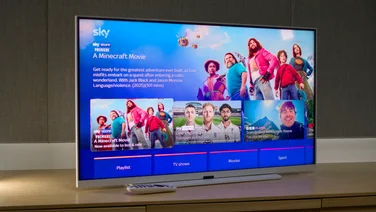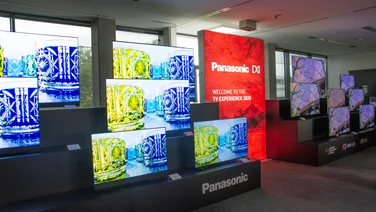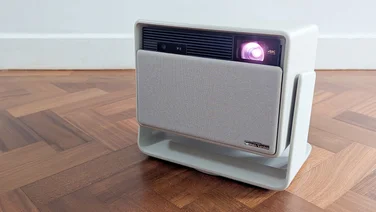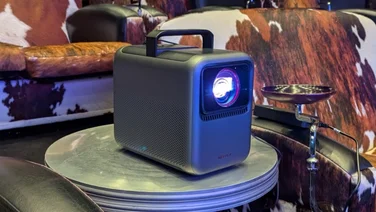To help us provide you with free impartial advice, we may earn a commission if you buy through links on our site. Learn more

- Dazzling HDR presentation
- Superb gaming responsiveness
- Effective anti-reflection screen filter
- Occasional motion stutter
- Posterisation in some HDR scenes
- Curved screen catches reflections
The Samsung UE65KS9500 is one of Samsung’s flagship televisions. This TV comes with a full-array of local dimming (FALD), which allows different segments on the screen to be illuminated and dimmed independently of each other, to generate deeper blacks and higher contrast. At the time of the review in January 2017, it was the only model in Samsung’s line-up to feature FALD technology.
The TV has also dropped in price, originally reviewed at £2,899, it can now be found for around £2,050 on eBay to £2,29 through PowerDirect. Read on to see if the television is worth it.
READ NEXT: Our guide to the best 4K, HDR and 1080P TVs to buy
Samsung UE65KS9500 review: Design
Since 2014, Samsung’s flagship TV has adopted a curved screen, and it’s a handsome devil, too: the relatively slender bezel and Y-shaped table-top stand make for a fine-looking TV. The 65KS9500’s chassis is admittedly chunkier than edge-lit LED LCDs and OLED TVs due to the FALD backlighting technology – the LED backlight modules are placed directly behind the panel instead of just along the edges – but I suspect it’s a trade-off most people will be happy to make in exchange for superior image quality.
Samsung UE65KS9500 review: Picture quality
HDR material is where the Samsung KS9500 truly shines, thanks to its high peak brightness and detail-preserving tone-mapping – a feature which allows the Samsung to retain the optimum amount of detail in the darkest and brightest parts of HDR material. And when I say bright, I mean seriously bright: peak luminance comes in above 1400cd/m2 even once the TV is calibrated to industry standard levels of accuracy. This allows specular highlights such as reflections off shiny objects (for example the vehicle grilles in The Grand Tour or the robotic armour in Pacific Rim) to dazzle in a convincing and realistic manner that’s never going to be replicated on dimmer displays. The really good news is that the Samsung’s FALD array can sustain this level of peak brightness pretty much indefinitely, unlike edge-lit Samsungs and Sonys whose peak luminance drops off quite dramatically after around 30 seconds.
Samsung also has another HDR-friendly trick up its sleeve: it’s the only TV brand to analyse the metadata embedded in Ultra HD Blu-rays and adjust its tone-mapping curve accordingly. This ensures that highlight detail, such as subtly different layers of cloud on a bright day, is not lost, and the benefits of such an approach are clearly visible on the UE65KS9500. The Sony ZD9 can go even brighter than the Samsung (up to 1800cd/m2, in fact), but because the former maintains the same tone-mapping curve irrespective of HDR metadata, some extremely bright detail in movies tends to get blown out. That said, the UE65KS9500 isn’t flawless in this regard: we did notice more posterisation (i.e. smooth gradients of colour are wrongly displayed in distinct steps) in certain scenes than TVs from other brands.
Peel your eyes away from its spectacular HDR presentation, and you’ll find that the Samsung is equally adept at handling SDR (standard dynamic range) material too. Viewing angles aren’t as good as rivals which use other display technologies, but as long as you watch the television from head-on, contrast and colours pop from the screen with a vibrancy that transcends the underlying LCD technology, and there are plenty of picture-tweaking controls stowed under the
[Expert Settings]
submenu which you can use to adjust the image either to reference standard or to your particular preference.
Special praise also has to be given also to the 65KS9500’s anti-reflective filter (dubbed “moth-eye” by Samsung) which mutes ambient light and glare more effectively than most TVs on the market. The only chink in the Samsung’ armour is a tendency for the curved panel to spread reflections caught from certain spots horizontally across the screen, which can be a tad annoying.
Samsung UE65KS9500 review: HDR gaming and motion performance
Gamers who are into reflex-based games will find the Samsung UE65KS9500 extremely responsive to play on – input lag measured merely 21ms with
[Game]
mode enabled. This low latency is available in HDR mode too, but you have to manually bump
[Backlight]
to “20” and
[Smart LED]
to “High” for maximum HDR impact because the
[Game Mode]
settings are the same between SDR and HDR modes.
If there’s another small complaint to make about the Samsung, it’s that its motion performance could be better. For some reason, engaging black frame insertion via
[LED Clear Motion]
doesn’t enhance motion clarity, and the TV exhibits occasional stutter from interlaced broadcasts, notably during sports broadcasts in the transitions from slo-mo replays back to live action.
Click here to read Vincent’s full test results over at HDTVtest.co.uk
Samsung UE65KS9500 review: Verdict
It might not emerge from our stringent tests with a completely clean bill of health, but then few TVs do – and make no mistake, the Samsung UE65KS9500 is one of the best TVs we’ve reviewed, especially if you can find it cheaper than its original £2,899 price tag. If you’re looking for a truly stunning HDR TV, then Samsung’s flagship is a veritable tour de force.








